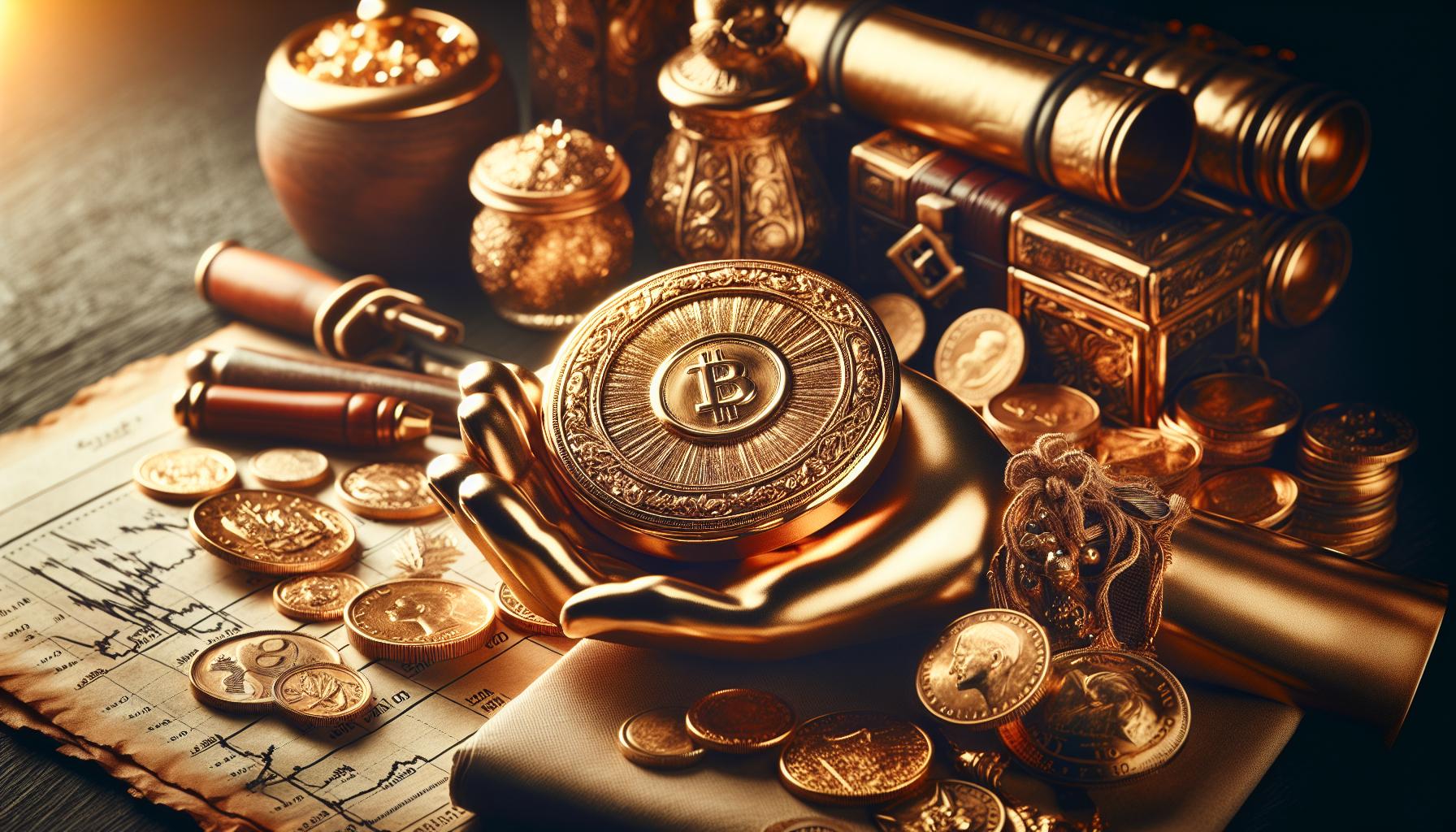How much dose the price of gold really change from one day to the next? Understanding gold’s daily fluctuations is crucial for investors and enthusiasts alike, as its volatility can influence market trends and investment strategies. By dissecting these patterns, we can better navigate this precious metal’s complex landscape and make informed financial decisions.
Understanding Daily Gold Price Fluctuations: What Do the Numbers Mean?
Observing the daily shifts in gold prices can feel like tracking a roller coaster ride.One moment, the price soars, and the next, it tumbles, stirring intrigue and speculation among investors. Understanding these fluctuations is key to navigating the gold market effectively. But what do the numbers really signify, and how can you make sense of them in relation to your investment strategy?
To grasp how much gold fluctuates daily, it’s essential to delve into the various factors driving these changes. Economic indicators, geopolitical events, and shifts in currency valuations all play crucial roles. For example, when economic data from major economies, such as the U.S.or China, is released, it can swing gold prices dramatically. Central banks’ policies and movements in interest rates, particularly in the context of inflation, also influence how gold is perceived as a safe haven during economic uncertainty.
Key Factors Influencing daily gold Prices
- Market Demand and Supply: High demand for gold in jewelry and technology can push prices up, while an oversupply can lead to decreases.
- Geopolitical Stability: Events such as wars or elections can drive investors towards gold, increasing its price.
- Currency Strength: A weaker U.S. dollar often makes gold cheaper for investors using other currencies, thereby driving up demand.
- Technical Trends: Traders frequently enough rely on ancient price patterns and technical indicators to make buy or sell decisions, which can lead to short-term volatility.
To better illustrate how these dynamics come into play, consider the fluctuations reported over a week.The table below showcases hypothetical daily price changes and highlights how quickly sentiment shifts can impact the value of gold.
| date | Gold Price (USD/oz) | change (%) |
|---|---|---|
| Monday | $1,800 | N/A |
| Tuesday | $1,815 | +0.83% |
| Wednesday | $1,775 | -2.20% |
| Thursday | $1,790 | +0.85% |
| Friday | $1,805 | +0.84% |
This table reveals the ebb and flow of gold prices throughout the week, reflecting how a mix of market sentiment and external events can influence their value. As an investor, riding the waves of volatility can result in important gains, but it also requires a watched strategy and mindful planning.
Recognizing these trends and patterns can empower you to make informed decisions. Keeping a close watch on the news, economic forecasts, and historical data can provide deeper insights into potential market movements, equipping you with the knowledge to act swiftly when needed.
The Factors Driving Gold’s Daily Volatility: Economic Indicators and Market Trends
the intricate dance of gold prices in the market can frequently enough seem erratic or unpredictable. Yet, beneath this surface volatility lies a tapestry woven from various economic indicators and market trends that investors and traders must understand to navigate the commodities landscape effectively. In the world of precious metals, fluctuations continue to tease out opportunities and risks alike, driving everyday decisions for those engaged in trading and investment.
Understanding how much gold fluctuates daily involves a keen awareness of multiple factors that can influence its price. Among these, economic indicators play a significant role. As a notable example, interest rates are a critical determinant; as rates rise, so does the opportunity cost of holding non-yielding assets like gold, frequently enough leading to a drop in demand. Conversely, lower rates can stimulate interest in gold, as it becomes a more attractive store of value during periods of economic uncertainty. Moreover, inflation is another vital component—gold is often viewed as a hedge against inflation, leading investors to flock to it when inflation rates surge, driving up its price.
Additionally, geopolitical events can create ripples in the market. For example, tensions in major oil-producing regions can lead to fears over supply disruptions, which often boosts gold’s appeal as a safe haven. The impact of such events can be illustrated in the table below:
| Geopolitical Event | Gold Price Reaction |
|---|---|
| Middle East Conflict | Prices Increase due to Flight to Safety |
| U.S.-China Trade Tensions | Increased Demand for Gold as a hedge |
| Natural Disasters | Rise in Prices from Economic Uncertainty |
| Major Economic Sanctions | Potential Increase in Prices due to Market Speculation |
market trends, including shifts in demand and technological advances in mining and production, also contribute to gold’s daily volatility. The rise of exchange-traded funds (ETFs) has democratized gold investment, allowing everyday investors to buy into the market without needing to own physical gold. This inclusion often magnifies market movements as it allows larger volumes of trade in response to news—notably affecting how much gold fluctuates daily. Moreover, the emergence of gold-backed cryptocurrencies and the growing importance of environmental, social, and governance (ESG) factors can add additional layers of complexity to the gold market, further influencing price dynamics.
In sum, keeping an eye on economic indicators, geopolitical events, and market trends is essential for anyone looking to make informed decisions regarding gold investments. Understanding these drivers will not only help one gauge current market conditions but also offer insights into potential future fluctuations in the gold market.
Historical Gold Price Patterns: Learning from the Past to Predict Future Movements
Understanding historical patterns in gold prices can substantially enhance our ability to forecast future movements. Over the decades, gold has demonstrated various volatility patterns, often reacting to global economic changes, geopolitical tensions, and shifts in investor sentiment. By examining these patterns, one can gain actionable insights into how much gold fluctuates daily and what might lie ahead.
Key Historical Patterns
several notable trends have emerged from the historical analysis of gold prices:
- Inflation Hedge: Gold often sees increased demand during periods of high inflation, typically leading to price surges as investors seek a stable store of value.
- Economic Cycles: Prices can fluctuate significantly in response to economic expansions and recessions. During a downturn, gold usually appreciates as a safe haven.
- Geopolitical Tensions: Wars, conflicts, and political instability often drive up gold prices as markets react to uncertainty.
- Central Bank Policies: actions taken by central banks, particularly interest rate changes, directly impact gold prices, showing a consistent pattern of price adjustment following monetary policy announcements.
Data Insights: Volatility patterns Over Time
To illustrate the patterns of gold price volatility, consider the following table showcasing historical price changes alongside notable events:
| Year | Average Gold Price (USD/oz) | Key Events |
|---|---|---|
| 2008 | $872 | Global Financial Crisis |
| 2011 | $1,571 | Debt Crisis in Europe & Bull market |
| 2020 | $1,773 | COVID-19 Pandemic & Economic Shutdowns |
| 2022 | $1,790 | High Inflation & Geopolitical Tensions |
Practical Submission for Investors
By studying these historical fluctuations, investors can develop strategies to navigate gold’s volatility.
- Monitor Economic Indicators: Keep a close eye on inflation rates, employment data, and central bank announcements.Understanding these factors can definitely help forecast potential price swings.
- Diversify Portfolios: Incorporating gold into an investment portfolio can provide a buffer against market downturns. Consider a balanced approach with other asset classes to mitigate risks.
- Stay Informed: Regularly follow news related to geopolitical events and economic health. Being well-informed can lead to more timely investment decisions.
Through this lens, it becomes evident that while predicting gold price movements is complex, drawing lessons from the past can empower investors to make informed choices in a dynamic market.
How Global Events Impact Gold Prices: The role of Geopolitics and Economic Data
Gold has long been regarded as a safe haven asset, its allure amplified during times of uncertainty. From geopolitical tensions to fluctuating economic indicators, various global events significantly influence the price of this precious metal. Understanding these dynamics is crucial for investors and those curious about the volatility of gold prices,especially when contemplating questions like “How Much Does Gold fluctuate Daily? Volatility Patterns Explained.”
The Influence of Geopolitics
Geopolitical events are among the most pivotal factors affecting gold prices. Conflicts, trade wars, and diplomatic tensions often lead to an increase in demand for gold, as investors seek stability.
- Military Conflicts: Escalating hostilities in regions such as the Middle East typically drive investors towards gold, swelling its price.
- Trade Wars: Tensions between major economies,like the U.S. and China, can cause market volatility, prompting investors to flock to gold as a hedge against uncertainty.
- Political Instability: Events such as elections in politically volatile nations can trigger rapid shifts in gold prices, reflecting investor sentiment towards stability.
for example, during times of heightened tension, such as the early stages of the COVID-19 pandemic, gold witnessed a significant price surge as investors reacted to the instability brought about by the crisis.
The Role of Economic Data
Economic indicators also play a critical role in determining gold’s volatility. Key data such as inflation rates, employment figures, and interest rates can make substantial impacts.
| Economic Indicator | Impact on Gold Prices |
|---|---|
| Inflation Rates | Higher inflation typically boosts gold demand as it is viewed as a hedge against currency devaluation. |
| Interest Rates | Low interest rates frequently enough lead to increased gold buying, as the opportunity cost of holding gold versus interest-bearing assets diminishes. |
| Unemployment Rates | High unemployment can lead to economic uncertainty, increasing gold’s appeal as a safe investment. |
As inflation rates rise, as an example, gold prices tend to follow suit as investors look for ways to preserve their wealth. In contrast, when central banks raise interest rates, gold frequently enough sees a decrease in demand, leading to lower prices.
By keeping a close eye on geopolitical developments and economic indicators,investors can better anticipate fluctuations in gold prices and make informed decisions. These insights not only deepen understanding of gold’s volatility but also empower investors as they navigate the often unpredictable tides of the global market.
Analyzing Gold’s Safe haven Status: Why Investors Turn to Gold in Uncertain Times
In times of economic uncertainty, gold has long been viewed as a refuge for investors seeking stability. The appeal of this precious metal stems from its historical role as a reliable store of value, especially when other assets falter. whether through inflation, geopolitical tensions, or stock market volatility, gold’s ability to maintain its worth makes it a cornerstone in many investment portfolios during turbulent times.
The Historical Context of Gold as a Safe Haven
Gold has been prized for thousands of years, not just for its beauty but for its intrinsic value. Unlike fiat currencies that can be devalued by government policy or economic conditions, gold’s supply is limited, making it inherently valuable. This scarcity is a key factor in why many turn to gold when faced with uncertainty. Notably, during events like the financial crisis of 2008 or geopolitical tensions in the Middle East, gold prices saw significant increases, underscoring investor confidence in the metal during crises.
Factors Driving Investors Towards Gold
A myriad of factors influence the influx of investment into gold during challenging times. Here are some of the most prominent:
- Inflation Hedge: Many investors flock to gold as a hedge against inflation. When currency values decline,gold often retains its purchasing power.
- Geopolitical Risks: Political instability or global conflicts tend to drive investors towards gold. As a notable example, during times of war or diplomatic strife, the demand for gold typically spikes.
- Market Volatility: As stock markets exhibit volatility, many investors seek refuge in gold, which often behaves differently than stocks. Understanding how much gold fluctuates daily can highlight these patterns.
Real-World Examples of Gold’s Safe Haven Status
Looking at historical price movements can provide insight into how gold performs during periods of instability. As an example, during the onset of the COVID-19 pandemic in early 2020, gold prices surged as investors sought a safe haven amidst widespread market sell-offs. The table below illustrates the fluctuation in gold prices before and after significant geopolitical events, showcasing its role as a protective asset:
| Event | Date | Gold Price Before ($) | Gold Price After ($) | Fluctuation (%) |
|---|---|---|---|---|
| COVID-19 Pandemic Declaration | March 2020 | 1,590 | 1,700 | 6.93 |
| U.S. Presidential Election | November 2020 | 1,880 | 1,960 | 4.26 |
| russia-ukraine Conflict | February 2022 | 1,800 | 2,000 | 11.11 |
As investors become increasingly attuned to the implications of economic shifts, recognizing the patterns of gold’s daily fluctuations and its function as a protective asset becomes essential. By integrating gold into their investment strategies, individuals can mitigate risks associated with uncertain times and safeguard their financial futures.
Practical Strategies for Navigating Gold Market Volatility: Tips for Investors
Understanding how gold prices fluctuate can be the key to mastering investments in this precious metal. The daily volatility of gold is influenced by various factors such as economic indicators, geopolitical tensions, and market trends. For investors looking to navigate this landscape, employing practical strategies can significantly mitigate risks and enhance gains.
Establish a Clear Investment Strategy
Before diving into the gold market, having a well-defined investment strategy is crucial. Investors should determine their risk tolerance,time horizon,and investment goals. This foundational knowledge will guide them in making informed decisions, especially during periods of volatility. For instance:
- Long-term Investing: If you plan to hold gold for several years, resist the urge to react to daily price fluctuations. focus on the long-term trends and fundamentals that influence gold prices.
- Short-term Trading: If you prefer active trading, stay updated with current news and trends that could cause immediate price shifts. Utilize technical analysis to identify entry and exit points.
Diversify Your Portfolio
One of the best ways to withstand gold price fluctuations is by diversifying your investment portfolio. Consider including a mix of assets such as stocks,bonds,and commodities alongside gold. This reduces the impact of volatility during downturns.For example, if gold prices are declining, other sectors like technology or healthcare may perform well, providing a cushion against losses.
| Asset Class | Typical Volatility | Correlation with Gold |
|---|---|---|
| Gold | Moderate | – |
| Stocks | High | Varies |
| Bonds | Low | Negative |
| Cryptocurrency | Very High | Varies |
Utilize Hedging Techniques
Hedging is a powerful method to manage risk in any investment strategy, including gold trading. Investors might employ options contracts or futures to protect against adverse price movements. for instance,purchasing put options provides the right to sell gold at a predetermined price,which can limit losses in case of a market downturn. Additionally, consider allocating a small percentage of your portfolio to gold ETFs, as they usually have lower management fees compared to physical gold ownership, while allowing for easy buying and selling during volatile periods.
By implementing these strategies, investors can better navigate the turbulent waters of the gold market and mitigate the impact of daily fluctuations explained in “How Much Does Gold Fluctuate Daily? Volatility Patterns explained.” Keeping abreast of market trends and maintaining a disciplined approach can transform potential volatility into opportunities for growth.
The relationship Between Gold and Other asset classes: Diversification Insights
The allure of gold as an investment is well-documented, but what often goes unnoticed is how this precious metal interacts with other asset classes, providing a unique lens through which investors can view their portfolios. Understanding these relationships is crucial for smart investing, especially in times of economic uncertainty. In addition to being a hedge against inflation and market volatility, gold’s daily fluctuations can influence or be influenced by key economic indicators and asset groups, thereby affecting investment strategies.
Gold’s Role in Portfolio Diversification
When it comes to portfolio diversification, gold plays a significant role. Due to its low correlation with customary assets like stocks and bonds, gold can act as a stabilizing force during market downturns. Investors often turn to precious metals when the stock market is experiencing high volatility,primarily due to the inverse relationship between these asset classes.
- Inflation Hedge: Gold is often viewed as a safe haven during inflationary periods.While equity markets may dip due to rising prices, gold tends to retain or even increase its value.
- Market Downturns: Historical data shows that during significant stock market declines, gold prices frequently enough rise.
- Currency correlation: Gold prices typically move inversely to the strength of the US dollar; a weaker dollar can lead to higher gold prices.
As an example,during the 2008 financial crisis,as stock indices plummeted,gold prices soared,showcasing the metal’s resilience and appeal as a safe haven. This resilience can be leveraged to enhance portfolio performance, especially when investor sentiment shifts rapidly.
Analyzing Volatility patterns
When assessing how much does gold fluctuate daily? Volatility patterns reveal crucial insights about its interaction with other asset classes. gold generally exhibits lower daily volatility compared to stocks, making it a more stable option for risk-averse investors.
| Asset Class | Average Daily Fluctuation (%) | Correlation with Gold |
|---|---|---|
| Gold | 0.5 | – |
| US Stocks | 1.5 | 0.1 |
| US Bonds | 0.3 | 0.2 |
| Real Estate | 0.6 | 0.05 |
this table underscores the comparative daily fluctuations across different asset classes. The relatively lower volatility of gold, at around 0.5%, compared to stocks demonstrates its role as a stabilizing asset in turbulent times. understanding these dynamics allows investors to adjust their allocations strategically, helping to weather economic storms while still participating in growth opportunities offered by other assets.
gold’s behavior in conjunction with other asset classes underscores its value in a balanced portfolio. By leveraging its unique volatility patterns, investors can make informed decisions, optimizing their strategies for better long-term financial health.
Tools and Resources for Monitoring Gold Prices: Staying Informed on Market Changes
In a market as dynamic and unpredictable as gold trading, keeping up with daily price fluctuations can feel like navigating a turbulent sea. Did you know that gold prices can swing considerably within just 24 hours, influenced by factors such as geopolitical events, economic indicators, and changes in investor sentiment? To effectively track these changes, utilizing the right tools and resources is essential for both novice investors and seasoned traders alike.
Essential Tools for Tracking Gold Prices
when it comes to staying informed about gold price movements, several reliable tools can greatly assist you. Here are some of the most popular options:
- Financial News Websites: Websites like Bloomberg, CNBC, and Reuters provide real-time updates and analyses on gold prices, frequently enough accompanied by expert commentary.
- Mobile Apps: Applications such as Kitco and Gold Live allow users to get instant notifications regarding price changes right on their smartphones.
- Market Analysis Platforms: Tools like TradingView and MetaTrader offer advanced charting capabilities that enable users to visualize price trends and patterns effectively.
- Social Media Channels: Follow reputable financial analysts and market experts on platforms like Twitter or LinkedIn for timely updates and insights on gold market volatility.
Utilizing Economic Indicators
to truly understand how much gold fluctuates daily, it’s vital to monitor key economic indicators that influence gold prices. For instance, reports on inflation rates, employment data, and central bank policies significantly impact investor behavior.setting up alerts for these reports through websites like tradingeconomics can help investors stay ahead of market trends.
The Role of online Forums and Communities
Engaging with online communities dedicated to gold trading can offer invaluable insights.Forums like Reddit’s r/investing or dedicated Facebook groups often discuss current events affecting gold prices and share predictions based on real-time data. Participating in these discussions can enhance your understanding of market sentiment,helping you make well-informed decisions.
With the right combination of tools, resources, and community engagement, keeping track of daily gold price fluctuations could shift from a daunting task to an exciting journey in investment. Remember,thriving in a volatile market is about being informed and adaptable,utilizing the tools at your disposal to navigate each twist and turn effectively.
Faq
How Much Does Gold Fluctuate Daily? Volatility Patterns Explained?
The daily fluctuation of gold prices can vary significantly, typically ranging from a few dollars to over $30 per ounce. This fluctuation is influenced by market trends, economic data releases, and global events.
Factors influencing gold’s daily volatility include geopolitical tension, interest rates, and inflation data, all of which can cause abrupt price shifts.Such as,unexpected news about an economic crisis can lead to increased demand for gold as a safe-haven asset. For a deeper dive into factors impacting gold prices, check our article on gold pricing factors.
What factors influence gold price fluctuations daily?
Gold price fluctuations are influenced by several key factors, including economic indicators, currency strength, and market speculation. Typically, the price changes daily as traders react to these variables.
Such as, if the U.S. dollar weakens against other currencies, gold often becomes more expensive in dollar terms, leading to price increases. Additionally, major news events, such as announcements from central banks about interest rate changes, can significantly sway investor sentiment and gold prices.
Why does gold exhibit high volatility?
Gold’s high volatility is primarily due to its status as a safe-haven investment.During times of uncertainty, investors flock to gold, causing prices to swing widely based on market sentiment.
Moreover, gold is sensitive to changes in global economic conditions. Economic downturns or political instability often spike demand for gold, leading to increased buying pressure and, consequently, price volatility. Understanding these dynamics can help investors make informed decisions in the volatile gold market.
Can I predict how much gold will fluctuate daily?
While it’s challenging to precisely predict daily gold fluctuations,trends and historical patterns can provide insights. Analyzing market data, economic reports, and geopolitical events can help forecast potential price movements.
Investors frequently enough use tools such as technical analysis and historical price charts to anticipate changes. Though, unexpected events can still lead to abrupt price shifts, making it essential to stay informed about market news.
What historical patterns exist in gold price fluctuations?
Historically, gold prices have displayed patterns of volatility during periods of economic uncertainty, such as financial crises or political upheaval. These events typically lead to rapid price increases as investors seek stability.
Notably, after the 2008 financial crisis, gold prices soared as investors sought safe assets.Understanding these historical fluctuations can assist current investors in making informed choices that align with historical trends.
How frequently enough does gold price change?
Gold prices are updated continuously throughout each trading day on global exchanges. Prices can change multiple times within a single hour due to trading activity and economic news.
Factors such as trading volumes and market demand influence how frequently gold prices shift. Because of its active trading and the ongoing influence of various market dynamics, staying up-to-date with real-time price data is crucial for investors.
Why does gold become more volatile during certain times of the year?
Gold often experiences higher volatility during key periods such as holiday seasons or economic reporting dates. Demand for gold jewelry spikes during major cultural festivals, affecting price dynamics.
Moreover, quarterly financial reports and significant economic indicators released by governments and central banks can lead to rapid price adjustments. These seasonal trends can present both opportunities and risks for investors in the gold market.
To Wrap It Up
understanding the daily fluctuations of gold is essential for anyone invested in this precious metal, whether for financial gain or personal adornment.As we’ve explored, volatility patterns in the gold market can be influenced by a myriad of factors—ranging from geopolitical tensions to economic indicators and shifts in consumer demand.By recognizing these dynamics, you can make informed decisions that align with your investment goals or personal preferences.
We invite you to delve deeper into the complexities of the gold market and engage with our resources tailored for both seasoned investors and those simply curious about gold’s allure. Consider keeping up with market trends, sign up for our newsletter, or explore further articles that unravel the layers of this fascinating commodity.Gold is not just a financial asset; it’s a storied element that has captivated humanity for centuries. Embrace the journey of discovery and enrich your understanding of this timeless treasure.






